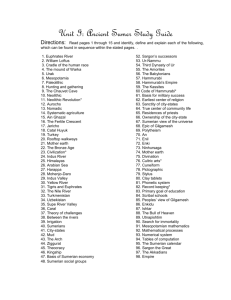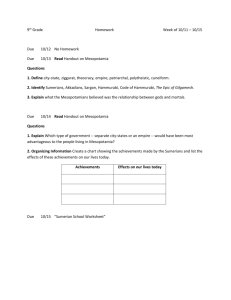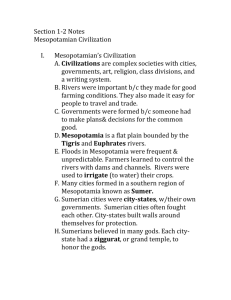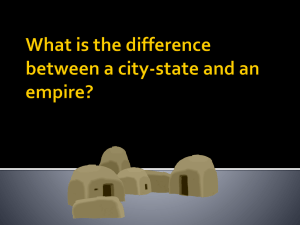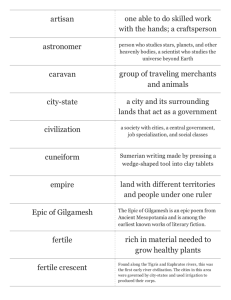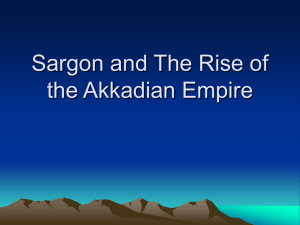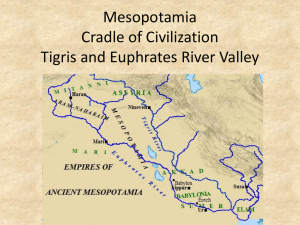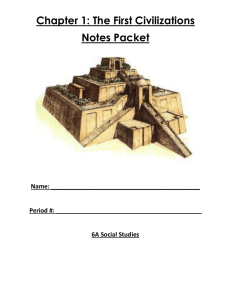Social Studies Chapter 2: Early Civilizations Activities 1. Time line
advertisement
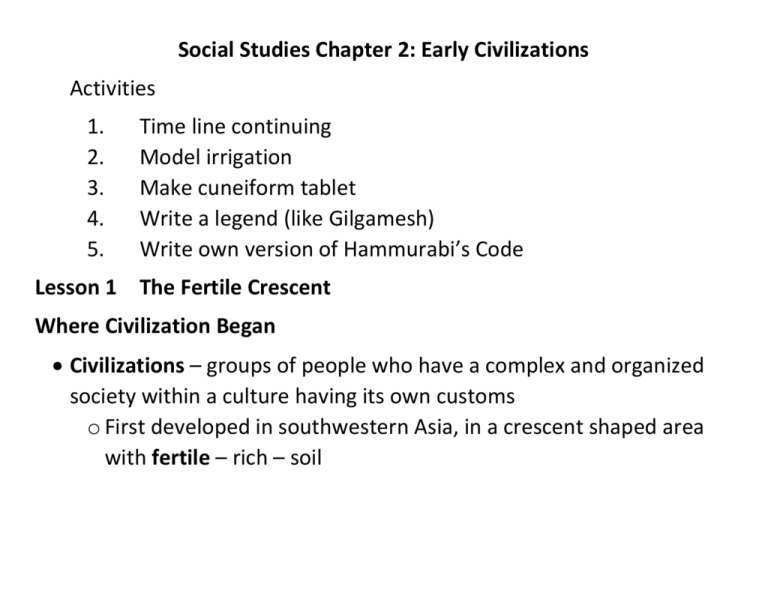
Social Studies Chapter 2: Early Civilizations Activities 1. 2. 3. 4. 5. Time line continuing Model irrigation Make cuneiform tablet Write a legend (like Gilgamesh) Write own version of Hammurabi’s Code Lesson 1 The Fertile Crescent Where Civilization Began Civilizations – groups of people who have a complex and organized society within a culture having its own customs o First developed in southwestern Asia, in a crescent shaped area with fertile – rich – soil o Fertile Crescent – land stretching from the eastern shores of the Mediterranean Sea between the Tigris and Euphrates Rivers to the mouth of the Persian Gulf Was a curved area of land good for growing crops Some countries in this area today are Iraq, Syria, and Israel Diverse area of plants, animals, and landforms o A plain – area of flat land – bordering both the Tigris and Euphrates became known as Mesopotamia o Mesopotamia – “the land between two rivers” emerged as one of the first civilizations Climate and Rivers The climate was not good for farming due to long, hot, and dry summers with temperatures up to 120 F o No rain from May to October o From November to April, occasional heavy rains would flood the plain Around 5000 BC, people moved from a plateau – high area of flat land – down to the plain Tigris and Euphrates provided fresh water and fish and solution to low rainfall o Farmers built irrigation systems – trenches and ditches that brought the water from the rivers to their fields The People People of southern Mesopotamia were problem solvers o No rain = irrigation from the rivers o Few trees and stone = river reeds for huts and bricks made with mud and straw Herders had domesticated goats, cattle, and sheep Farmers grew barley, millet, wheat, dates, lentils, onions, garlic, turnips, lettuce, cucumbers, and apples o Developed advanced farming techniques that allowed them to grow surplus food Growth of City-States and Trade Surplus food caused the population to grow By 3,500 BC, the villages of Uruk, Kish, Lagash, Nippur, Umma, and Ur grew into city-states o City-state – a city that is an individual unit, complete with its own form of government and traditions Mesopotamia was a region – area with common physical features – where no one single power controlled all the city-states Because of surplus food, people could do other jobs o Religious and government leaders o Artisans – craftspeople – like potters and weavers o They were paid with food Traders began to trade crops and woven cloths with other Mesopotamian city-states by reed boats traveling along the rivers o They also traded with other cultures either by foot, or by wooden boats across the Persian Gulf o They would trade copper, stone, and other materials they lacked as well as cultural richness Lesson 2 Mesopotamia Sumer and Akkad The earliest city-states were Sumer – southern Mesopotamia – and Akkad – northern Mesopotamia The people were similar in most ways, except language In Sumer, the Sumerians spoke Sumerian In Akkad, the Akkadians spoke Akkadian, which is related to Hebrew These city-states would have wars over control of land o Between 3500 BC and 2330 BC, Sumer was more powerful Uruk was a Sumerian city, home to as many as 50,000 people o Most city-states were surrounded by mud brick walls for protection Houses were made of mud brick and painted white to keep them cool Highest point in each city was the temple complex o Ziggurat – a series of stacked rectangular platforms that formed a huge pyramid-shaped structure Reached heights up to 290 feet and were believed to link the heavens and Earth Religion and Government Size and magnificence of temples reflect the importance of religion to society – organized community with established rules and traditions Polytheism – worship of many gods – was practiced by the Sumerians and Akkadians o Their chief gods: Anu – god of the heavens Enlil – god of wind Enki – god of water Ninhursag – mother of the gods o They also had many lesser gods If things were going well, they believed the gods were pleased o Temple priests made offerings of incense, food, and drink o Divine kingship, the right to rule being god-given, was first practiced by the Sumerians Believed this right was passed from father to son (impacted later civilizations) There was a class system in Sumer that also appeared in later civilizations: o King o Wealthy business people, landowners, and government workers o Artisans and farm workers o Slaves Writing About 3200 BC, the Sumerians invented a system of writing to keep track of business transactions and trading Earliest forms were simple pictures that stood for objects or actions o By 2400 BC, the pictographs were simplified A scribe – professional writer – pressed a reed into wet clay tablets, leaving wedge-shaped markings o The tablet dried creating a permanent record Cuneiform – form of wedge-shaped writing created by the Sumerians and adopted by the Akkadians Writing was not only used for the exchange of goods, but archaeologists have also uncovered medical texts, law codes, letters, wise sayings, and even literature o The Epic of Gilgamesh was a tale of the adventures of the legendary Sumerian king, Gilgamesh Gilgamesh (Biography) May or may not have been a real person Many historians believe he was the 5th king of Uruk around 2700 BC o By 2000 BC, so many stories had been told about Gilgamesh, that he became a mythical figure A set of 12 clay tablets from the 600s BC give the best-known epic of Gilgamesh that may not be based on any historical facts o The themes include many human experiences o Gilgamesh wants to live forever, is given a task to complete, and fails; so he must acknowledge his fate The Rise and Fall of the Akkadian Empire About 2334 BC, the Akkadian ruler, Sargon, took armies southward through Sumer, conquering – defeating – each city-state by overthrowing their kings Sargon united all Mesopotamian city-states, creating the world’s first empire – large territory, consisting of many different places, all under the control of a single ruler o His empire extended far beyond Mesopotamia Sargon appointed his daughter, Enheduanna, the high priestess of Ur o She was in charge of making offerings to Nanna, the moon god; and she composed songs to Inanna, the goddess of the morning and evening star Sargon passed his empire to his son, but the Akkadian dynasty – ruling family – was constantly threatened by revolts and only lasted about 150 years o By 2100 BC, Sumer rose to power again Sargon (Biography) What we know comes from documents and legend written after his death Legend says that Sargon was an abandoned baby, placed in a basket in the river o He was adopted by a farmer, and worked as a servant to the ruler of the Sumerian city of Kish o Sargon rose through the ranks and came to power after the defeat of Uruk, taking control of all other city-states He gave himself the name Sharru-kin, or “Rightful King,” and it is believed that the Mesopotamians accepted him as their king He seemed to be a just ruler, and held power for about 56 years (unusually long) Sumer’s Final Days The city-state of Ur held control of Mesopotamia for about 100 years under the power of the Sumerian king, Ur-Nammu and his son, Shulgi o Society and culture flourished during this time o The Ziggurat of Ur, one of the largest ever built, was built during this time (and ruins can still be seen) o The 1st wheel appeared in Mesopotamia about 5,000 years ago o Writing, the wheel, and ziggurats are some of the Sumerian things found in later cultures Lesson 3 Babylonia and Assyria The Rise of Hammurabi and Babylonia Following the fall of Ur in 2100 BC, people from the surrounding areas arrived in Mesopotamia and settled, adopting many of their customs for centuries In 1792 BC, Hammurabi became king of Babylon, a city-state between the Tigris and Euphrates o By 1754 BC, he controlled his empire, Babylonia, consisting of Mesopotamia and neighboring city-states o Hammurabi sought great power, sending officials to carry out orders and collect taxes Taxes went to pay for the army and construction projects throughout the empire Babylonian Civilization Farming, trade, religion, and class systems did not change much under Hammurabi’s rule o Babylonians spoke their own version of Akkadian The capital city of Babylon grew from a small village to a center of culture and learning o Clay tablets show advancements in math, literature, and law Code of Hammurabi – set of 282 laws that helped Hammurabi govern his empire in a new way o Some laws were similar to Sumerian and Akkadian laws o Rules dealt with business practices, property ownership, medical practices, marriage, and childcare o Most complete law code to have survived from Mesopotamia and shows Babylonian society o Purpose of code as written by Hammurabi: “to render (give) good to the people, to make justice shine in the land, to destroy the evil and wicked, that the strong do not oppress (mistreat) the weak” o Punishments varied based on the class of the lawbreaker and the victim of the crime Often demanded “eye for an eye” Hammurabi (Biography) Became king of Babylon in 1792 BC, and made allies with other kings to gain more power He wanted to control the Tigris and Euphrates Rivers to have control of the irrigation systems and farming economy Was a brilliant and brutal warrior, he would dam a waterway and then release it to flood the city His code of laws was his greatest achievement The Assyrians While the Babylonian Empire flourished in the south, the Assyrians began to gain strength in northern Mesopotamia From 1900 BC to 600 BC Assyria expanded its territory o Their culture was very similar to Babylonian culture, except with more emphasis on war and conquest – defeat – of other groups and were known as merciless warriors From 688 BC to 627 BC, the Assyrian Empire was at its largest under King Ashurbanipal, who controlled nearly all of the Fertile Crescent o Ashurbanipal was a great warrior and very educated (could read and write Sumerian and Akkadian) o He built a great library at Nineveh where he collected Sumerian, Akkadian, and Babylonian writings that have helped historians Babylonia Grows After 627 BC, Nebuchadnezzar II, crowned king of Babylon, took over much of the Assyrian Empire and ordered massive building projects to make Babylon glorious again o Some historians think the great ziggurat he built was inspiration for the Tower of Babel story in the Bible o Babylon was a wealthy trading city and center of learning Determined place value in math Astronomers made many advancements, including accurately predicting when solar and lunar eclipses would occur The new Babylonian Empire declined after Nebuchadnezzar II died in 562 BC and was later invaded by the Persians Lesson 4 Hebrews, Phoenicians, and Lydians The Hebrews Abraham – shepherd from Ur whom God told to leave his homeland and settle in Canaan where He would be their God o With this covenant – agreement – around 1800 BC, Abraham promised to only worship one God and He would look after the Hebrews Monotheism – the worship of only one God o Abraham is viewed as the father of Judaism Hebrews lived in Canaan for a long time before moving to Egypt where they were forced to become slaves Moses was chosen by God to lead the Hebrews out of slavery in Egypt, across the Sinai Desert to freedom between 1400 BC and 1200 BC God gave Moses the Ten Commandments, which provided guidance for the worship of God and rules for moral behavior instead of listing crimes and punishments o According to the Bible, the covenant with Abraham’s descendants – people who are born later into the same family – was also extended to the Hebrews fleeing Egypt Hebrew Bible Moses received the first 5 books of the Hebrew Bible at the same time he received the Ten Commandments o Those 5 books are the Torah – Hebrew for “to teach” – which is the sacred text for Judaism, providing guidance, laws, and stories of events It is against Jewish law to decorate the Torah scrolls themselves which are handwritten by scribes on animal parchment o It is against Jewish law to touch the Torah while reading it (must use a pointer) Israel and Judah According to the Torah, Hebrews settled in Canaan in about 12 tribes and won several victories over the Canaanites o An important victory was inspired by Deborah, a judge chosen by God to offer guidance and leadership in times of trouble Women usually did not have power, but she encouraged the military leaders to attack the Canaanites and that a woman would win the war During the attack, the Canaanite king escaped and was killed by a Hebrew woman named Jael Because she was correct, Deborah was viewed as a national leader Around 1000 BC, King David united the tribes to form the kingdom of Israel with Jerusalem as the capital o His son, Solomon, built a temple in Jerusalem to house the Torah Solomon was a wise ruler and the kingdom prospered in peace After Solomon’s death, the kingdom split into Israel in the north and Judah in the south Israel fell to the Assyrians in 722 BC, and Nebuchadnezzer II conquered Judah in 587 BC The Hebrews continued to follow their religion even though they had been conquered Judaism Today Jewish people still read the Torah and gather in synagogues – Jewish houses of worship They celebrate holidays such as the festival of Passover, honoring the escape from Egypt A rabbi – Hebrew for “master” or “teacher” – teaches Jews how to read the Torah in Hebrew Phoenicians and Lydians Solomon had a profitable trade relationship with the Phoenicians o They supplied the wooden beams used to build Solomon’s temple Phoenician territory was on the eastern edge of the Mediterranean, but they established many trade posts throughout their trade routes o Their most important trading post was at Carthage in North Africa Phoenicians were expert sailors, and even went into the Atlantic Ocean along the west coast (may have gone as far north as Europe) o Their trading promoted the exchange of new ideas as well as goods o Usually bartered for goods and services although some used bars or rings of silver Their most important contribution was helping to develop the modern alphabet o Started with cuneiform (700 characters) and by 1400 BC they had 22 simple characters each standing for a consonant (Greeks added vowels later) Lydians, from western Asia, invented the region’s first coins around 500 BC o Images and markings showed the value which was backed by the king o Soon, other people like the Greeks made their own coins
